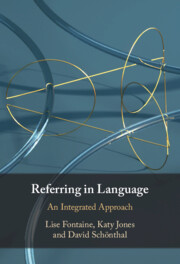Book contents
- Referring in Language
- Referring in Language
- Copyright page
- Contents
- Figures
- Tables
- Acknowledgements
- Part I The Nature of Referring and Referring Expressions
- Part II Typical Reference
- 4 Typicality and Atypicality
- 5 Referring in Spontaneous Discourse
- 6 Referring in Prepared Discourse
- Part III Atypical Reference
- References
- Index
5 - Referring in Spontaneous Discourse
from Part II - Typical Reference
Published online by Cambridge University Press: 22 June 2023
- Referring in Language
- Referring in Language
- Copyright page
- Contents
- Figures
- Tables
- Acknowledgements
- Part I The Nature of Referring and Referring Expressions
- Part II Typical Reference
- 4 Typicality and Atypicality
- 5 Referring in Spontaneous Discourse
- 6 Referring in Prepared Discourse
- Part III Atypical Reference
- References
- Index
Summary
This chapter examines typical uses of referring expressions in spontaneous discourse by building on the concept of context of situation and considering how parameters of register establish a framework for reference variation. We formulate a way to capture distinctions between what we can claim about typical referring expressions which approximate spontaneous production as compared to typical referring expressions when more planning and revising are involved. Focussing specifically on mode of production, our account of spontaneous reference is first situated by contextual parameters, and then described using evidence from examples attested in spontaneous discourse. This spontaneous vs planned distinction is useful for the study of reference, but we argue against a strict division. Typical reference in spontaneous discourse is shown to rely on highly accessible and in focus referents, which makes it easier for acts of reference to be successful and which reduces the cognitive load of the speaker and addressee.
Keywords
- Type
- Chapter
- Information
- Referring in LanguageAn Integrated Approach, pp. 92 - 107Publisher: Cambridge University PressPrint publication year: 2023

